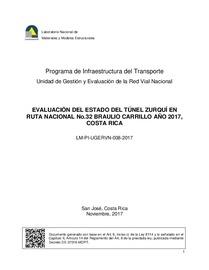EVALUACIÓN DEL ESTADO DEL TÚNEL ZURQUÍ EN RUTA NACIONAL No.32 BRAULIO CARRILLO AÑO 2017, COSTA RICA
Date
2017-11Author
Naranjo Ureña, Ronald
Valverde Cordero, Christian
Garro Mora, José Francisco
Sanabria Sandino, Jairo
Vega Salas, Paul
Barrantes Jiménez, Roy
Loría Salazar, Luis Guillermo
Metadata
Show full item recordAbstract
Se presentan los resultados obtenidos en la segunda evaluación del túnel Zurquí realizada por la Unidad de Gestión y Evaluación de la Red Vial Nacional, la primera evaluación se realizó en el año 2014. En general, esta estructura se encuentra en buen estado, sin embargo en esta oportunidad el pavimento dentro del túnel se observó más deteriorado que hace dos años. Este deterioro se atribuye a la presencia continua de agua sobre el pavimento en varios puntos. El agua se origina por un goteo intenso en varios sectores del techo del túnel. De los resultados obtenidos con el esclerómetro se determinó que el concreto lanzado que cubre las paredes del túnel tiene muy pocos sitios donde presentan valores de compresión inferiores de 19,6 MPa (200 kg/cm2), el resto de los ensayos presentan valores mucho más altos, lo que indica que el concreto no presenta problemas y sigue cumpliendo con las especificaciones de diseño. Sin embargo, este laboratorio ve necesario intervenir varios sitios puntuales donde el concreto lanzado se está viendo impactado por eflorescencias y presencia continua de agua. La iluminación en general sigue siendo buena dentro del túnel. Sin embargo en esta evaluación, se notó el sistema de iluminación más deteriorado que hace dos años. No se puede descuidar este aspecto, ya que podría generar un problema de seguridad para los usuarios.
Se insiste en que por la longitud este túnel y la posibilidad de ocurrencia de accidentes de tránsito que generen incendios, el túnel Zurquí debería de estar equipado con hidrantes, extintores y sistemas para controlar incendios en caso de un accidente de tránsito dentro de la estructura. Además de un sistema de comunicación (teléfono) para dar aviso a las autoridades en caso de alguna eventualidad. The results obtained in the second evaluation of the Zurquí tunnel carried out by the Management and Evaluation of the National Road Network Unit are presented in this report, the first evaluation was carried out in 2014. In general, the structure is in good condition, however in this opportunity the pavement inside the tunnel was observed more deteriorated than two years ago. This deterioration is attributed to the continuous presence of water on the pavement at several points. The water originates by an intense drip in several sectors of the roof of the tunnel. From the results obtained with the sclerometer it was determined that the sprayed concrete covering the walls of the tunnel has very few points with compression values under 19.6 MPa (200 kg / cm2), the rest of the tests presented much more higher values, which indicates that the concrete has no problems and keeps meeting the design specifications. However, this laboratory sees as necessary to intervene in several specific points where the sprayed concrete is being impacted by efflorescence and continuous presence of water. Lighting is in general still in good conditions inside the tunnel. However, in this evaluation, the lighting system was more deteriorated than two years ago. This aspect cannot be neglected, as it could generate a security problem for users.
It is insisted that due to the length of this tunnel and the occurrence possibility of traffic accidents that may produce fires, the Zurquí tunnel should be equipped with hydrants, fire extinguishers and fire control systems in case of a traffic accident inside the structure, in addition to a communication system (telephone) to give notice to the authorities in case of any eventuality.
Collections
- Informes [1102]

